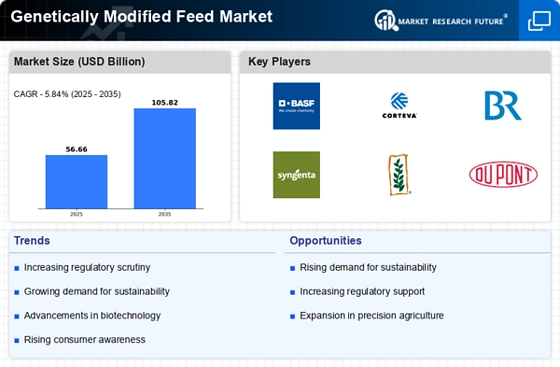Rising Demand for Animal Protein
The increasing global population and changing dietary preferences are driving the demand for animal protein. As consumers seek higher protein content in their diets, livestock production must scale up to meet this demand. The Genetically Modified Feed Market plays a crucial role in this context, as genetically modified feeds can enhance growth rates and feed efficiency in livestock. Reports indicate that the livestock sector is projected to grow significantly, with a compound annual growth rate of approximately 3.5% over the next decade. This growth necessitates the adoption of innovative feed solutions, including genetically modified options, to ensure sustainable production levels and meet consumer expectations.
Regulatory Support for Biotechnology
Regulatory frameworks supporting biotechnology are crucial for the growth of the Genetically Modified Feed Market. As governments recognize the potential benefits of genetically modified organisms in agriculture, they are increasingly establishing guidelines that facilitate the approval and commercialization of genetically modified feeds. This regulatory support can enhance consumer confidence and encourage farmers to adopt these innovative feed solutions. Moreover, as more countries implement favorable regulations, the market for genetically modified feeds is expected to expand. The alignment of regulatory policies with scientific advancements in biotechnology may lead to a more robust market environment, fostering innovation and growth in the sector.
Cost Efficiency in Livestock Production
Cost efficiency remains a pivotal driver in the Genetically Modified Feed Market. Genetically modified feeds are often designed to improve feed conversion ratios, which can lead to lower overall production costs for livestock farmers. By utilizing these feeds, farmers can achieve better weight gain and reduce the amount of feed required per unit of meat or milk produced. This efficiency is particularly important in a competitive market where profit margins are tight. Studies suggest that the use of genetically modified feeds can reduce feed costs by up to 20%, thereby enhancing the economic viability of livestock operations and encouraging broader adoption of these feed types.
Environmental Sustainability Initiatives
The push for environmental sustainability is increasingly influencing the Genetically Modified Feed Market. Genetically modified feeds can contribute to reduced greenhouse gas emissions and lower land use requirements by enhancing the efficiency of livestock production. For instance, crops engineered for higher yields can produce more feed on less land, which is essential in addressing the challenges of climate change and resource scarcity. Furthermore, the adoption of such feeds aligns with global sustainability goals, as they can help mitigate the environmental impact of livestock farming. As consumers become more environmentally conscious, the demand for sustainable feed options, including genetically modified varieties, is likely to rise.
Technological Innovations in Agriculture
Technological advancements in agriculture are significantly shaping the Genetically Modified Feed Market. Innovations such as precision agriculture, biotechnology, and data analytics are enhancing the development and application of genetically modified feeds. These technologies enable farmers to optimize feed formulations based on specific nutritional needs and environmental conditions, leading to improved livestock health and productivity. The integration of technology in feed production is expected to drive market growth, as it allows for more tailored and efficient feeding strategies. As the agricultural sector continues to embrace these innovations, the demand for genetically modified feeds is likely to increase, reflecting a shift towards more sophisticated farming practices.


















Leave a Comment